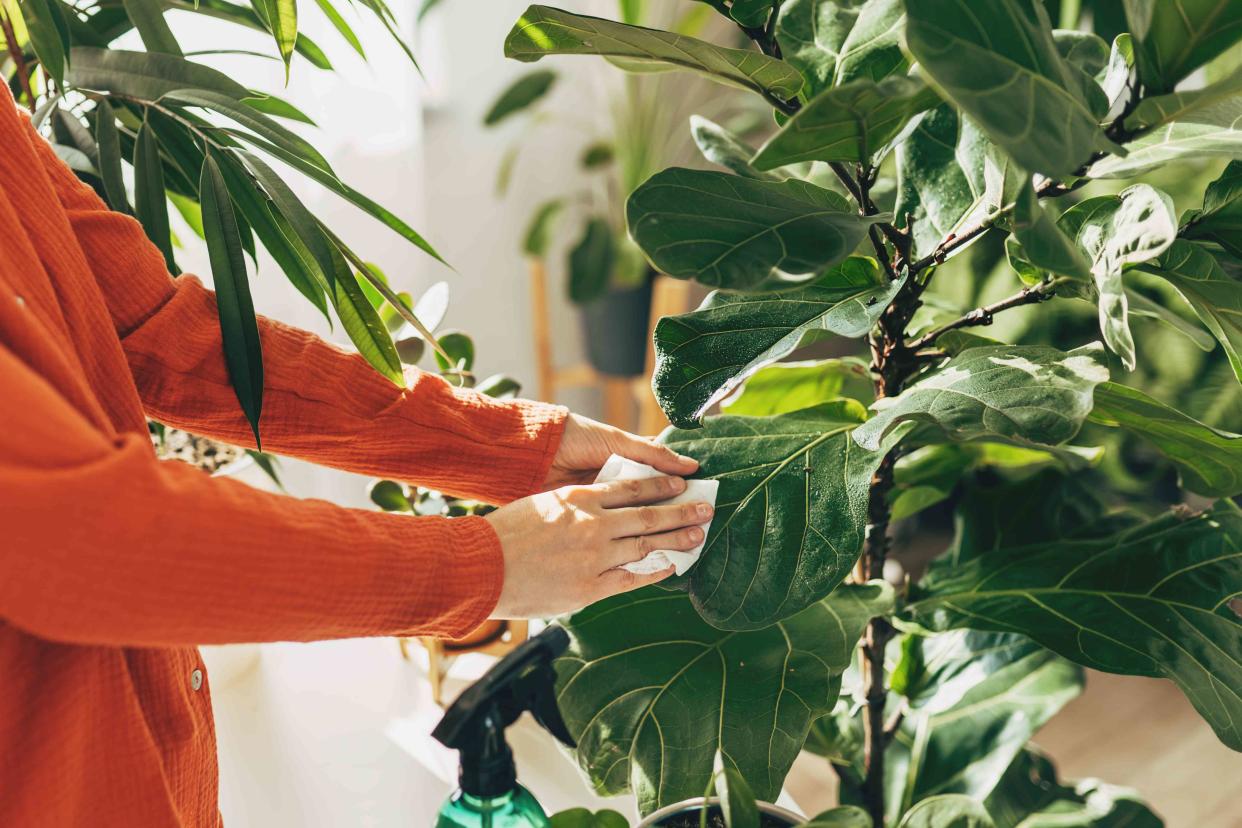The Right Way to Clean Plant Leaves for Healthier Houseplants
Fortunately, the right way is actually quite easy.

Kseniya Ovchinnikova/Getty Images
Wiping down your plant’s leaves every once in a while might seem a little extra, but it’s actually pretty important to squeeze this into your cleaning routine. If you don’t dust your plant regularly, it may actually start to suffer! “The dust will accumulate, and in turn, block the ability for complete sunlight absorption. Over time it can weaken the plant’s health and make it more susceptible to pests and other diseases,” says Rebecca Sterling, Easyplant’s resident plant expert.
Thankfully though, Sterling assures this doesn’t happen immediately, which means your plant isn’t doomed if you’ve been a little neglectful—there’s plenty of time to course-correct! If you’re looking for guidance, experts share tips for how to clean plant leaves for happier, healthier houseplants.
Related: 5 Things You Should Do for Your House Plants, Besides Just Watering Them
Meet Our Expert
Damp Versus Dry Dusting
Fortunately, in most cases, you don’t need to get super fancy with your dusting technique. The best thing to use for cleaning dirty plant leaves is a soft cloth, like a microfiber. If you’re torn between damp or dry dusting, consider the type of plant you’re cleaning and how dirty the foliage is.
According to Sterling, both damp and dry dusting options are equally effective and beneficial. “We’d recommend dusting more delicate plants with dry, soft cloth and using damp dusting methods for larger, smooth surfaced leaves, as long as you don’t leave the leaves dripping wet,” she says.
Lalicata adds that if you’re just dealing with dust, then dry dusting should suffice, but “if there happens to be other buildup or mineral deposits, a damp cloth can be more effective.” Note that as you dust, Sterling stresses, “It’s important to provide support to the back of delicate leaves, ensuring there’s no damage or tear to the plant.”
Tips
You can use a soft makeup brush to dust off fuzzy leaves.
The Shower Method
Most plants are fine with traditional dusting methods, but trailing plants are the exception to this rule. Enter the shower method. Lalicata says, “For trailing plants, or those with super small or hairy leaves, we would recommend showering the leaves with water at the time of watering.”
We’ve also seen folks literally “shower” their plants quickly in the sink or tub using lukewarm water, then giving them a very light shake at the end to wick off excess moisture. Please keep in mind though, you should only try this with plants in planters that have drainage holes!
Additives You Can Use to Clean
There are lots of recommendations out there that include adding a little bit of dish soap or castile soap to your plant cleaning solution, and technically you can do this as long as you’re extremely conservative with dosing. A few drops (less than a teaspoon) for a liter of water is more than enough.
Sterling says, “While plain water typically does the trick when it comes to cleaning leaves, there is always the option of using a mild solution of water and gentle soaps for those stubborn dirty spots. However, it’s crucial plant owners avoid harsh chemicals as those will immensely damage the plant’s health.” And don’t forget to wipe leaves with a water-dampened cloth after you apply the soap solution to really get rid of residue.
You can also use distilled white vinegar, Lalicata says. “Diluting a small amount of it in the water can help to get rid of any hard mineral deposits that build up on the leaves.” There are countless recipes on the interwebs that include other ingredients like lemon juice and neem oil—in fact, The Sill does produce their own sprays that contain these ingredients, as well—and these are all fine to add to your water, but keep in mind that less is best when it comes to dosing. Less than a teaspoon of any of these additives for one quart of water is ideal.
Are Leaf-Shining Products Good for Plants?
In general, it’s best to stay away from leaf-shining products. Many of those products contain oils or waxes that may “clog” your plant’s leaves. Additionally, it’ll leave a residue that can attract even more dust and dirt! If you’re regularly cleaning your plants, you’ll find you have no need for leaf-shining products.
How Often Should You Clean Your Plants?
According to both Sterling and Lalicata, this really depends on several factors. Lalicata says the environment and air flow are two of the biggest. “Some homes may get more dusty than others, especially those that don’t have air purifiers or proper air flow.” The general rule is about every two weeks, but Lalicata adds that some plants can get by on a monthly schedule. Of course, if you see a layer of dust forming, that’s also a good sign it’s time to polish off your plant!
Related: Here's Why Your House Is So Dusty—and How to Fix It
For more Real Simple news, make sure to sign up for our newsletter!
Read the original article on Real Simple.
